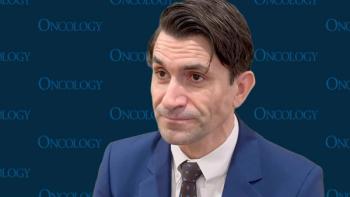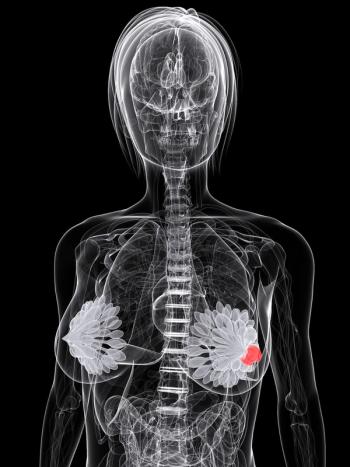
Balstilimab Combo Yields Survival Benefit in Soft Tissue Sarcoma
Most adverse effects in a phase 2 trial related to doxorubicin appear to be expected in the treatment of patients with soft tissue sarcoma.
Doxorubicin plus zalifrelimab and balstilimab produced a favorable progression-free survival at 6 months compared with doxorubicin alone in the treatment of patients with soft tissue sarcoma subtypes unlikely to respond to doxorubicin or immune checkpoint inhibitor (ICI) monotherapy, according to results from a phase 2 trial (NCT04028063) presented at the
Investigators reported an objective response rate (ORR) of 33.3% (95% CI, 17%-53%) and a disease control rate (DCR) of 80.0% (95% CI, 61%-92%).
“We saw responses in traditional ‘immune hot’ sarcoma subtypes, including angiosarcoma, undifferentiated pleomorphic sarcoma (UPS), and sclerosing epithelium fibrosarcoma,” lead author Breelyn Wilky, MD, the Cheryl Bennett and McNeilly Family Endowed Chair in Sarcoma Research, director of sarcoma medical oncology, and deputy associate director for clinical research at the University of Colorado Cancer Center in Aurora, Colorado, said in her oral presentation. “We were also excited to see responses in liposcarcoma, leiomyosarcoma, endometrial, stromal, and malignant peripheral nerve sheath tumor sarcoma,” continued Wilky, who is also an associate professor of medicine-medical oncology for University of Colorado Medicine.
Based on historical outcomes evaluating doxorubicin monotherapy and ICIs in soft tissue sarcomas, the median PFS ranges between 4.1 months and 6.8 months, an overall survival (OS) from 12.8 months to 197 months, and an ORR that is generally less than 20%, Wilky said. Further, other studies evaluating CTLA-4 and PD-1 blockade resulted in ORR of approximately 12% to 16% and a median PFS of about 3 to 4 months, according to Wilky.
The study was designed to determine if the combination of doxorubicin plus zalifrelimab and bastilimab could improve 6-month PFS rates compared with historical doxorubicin monotherapy. The primary end point was an improvement in PFS6mo by 20% over historical controls, or a 43.4% null rate. Secondary study end points included ORR, DCR, PFS, duration of response, overall survival (OS), and adverse events (AEs).
To be eligible for enrollment, patients were required to have locally advanced or metastatic soft tissue sarcomas, no prior anthracycline or ICI therapy, 0 or 1 prior lines of therapy for metastatic disease, and an ECOG performance status of 0 or 1.
During stage 1 of the study (n = 19), patients were initially treated with 300 mg of bastilimab every 3 weeks and 1 mg/kg of zalifrelimab every 6 weeks in a priming checkpoint inhibitor cycle; 75 mg/m2 of doxorubicin plus dexrazoxane was introduced 3 weeks later in cycle 2 (n = 14). Because of the potential for progression with ICI alone, the baseline scan for response occurred at the same time as the first dose of doxorubicin. As a result, 2 patients were allowed to receive up to 6 cycles of doxorubicin plus dexrazoxane for cardioprotection. Scans were obtained every 6 weeks.
“We noted a couple of patients in stage 1 who had rapid deterioration during the checkpoint inhibitor cycle; it was hard for them to wait for chemotherapy. This is not uncommon with rapidly progressing sarcomas,” Wilky said. In addition, patients who were progressing in stage 1 tended to do so on PD-1 maintenance therapy, which continued after completing zalifrelimab and doxorubicin.
“With all these factors taken into account, patients in stage 2 received doxorubicin, bastilimab, and zalifrelimab together, then zalifrelimab was continued along with a PD-1 maintenance therapy after completing doxorubicin,” Wilky said.
Of the 33 patients who received at least 1 dose of all study drugs, 22 came off study due to disease progression, 3 underwent surgery, 3 came off the study because of toxicity, 3 withdrew consent, 1 remains on study, and 1 completed the study. Thirty patients underwent at least 1 posttreatment scan, and 28 patients were evaluable for the primary end point.
Patients were evenly distributed across stage 1 and 2 for gender and 88% of patients were White. The majority (82%) of patients had metastatic disease, with most patients treated in the frontline setting. The most common subtypes in the study were dedifferentiated liposarcoma (24%), soft tissue/visceral leiomyosarcoma (24%), and other (24%).
Overall durability of responses were promising, with the longest responses extending past the 6 month progression-free time point. Looking at the primary end point, though, Wilky noted that PFS rate at 6 months was 46.4% (95% CI, 28%-65%) and the median PFS was 24.4 weeks (range, 23.4-72.9). The historical median PFS for doxorubicin monotherapy had been reported at 4.1 to 6.8 months. Median OS was 63 weeks (range, 50-120) and the median follow-up time was 95 weeks (range, 84.3-not available). Historically, doxorubicin monotherapy had a median OS of 12.8 to 19.7 months.
“Thus, we were unable to reject the null median [OS] for all patients,” said Wilky.
Regarding safety and toxicity, most AEs were expected and related to doxorubicin, including hematologic toxicity, mucositis, nausea, and vomiting, Wilky said.
Wilky also explored the effect of the treatment schema, comparing stage 1 with stage 2. She noted that in stage 2, median PFS and DCR were similar to stage 1, but ORR in stage 2 was 7% (95% CI, 0%-34%) compared with 56.2% (95% CI, 30%-80%) in stage 1. She suggested that this could be a patient selection phenomenon, and that in stage 1 the presence of ‘immune hot’ subtypes could have affected the results because stage 2 had ‘colder’ immune subtypes.
“We are going to have to dig through the correlates from this trial, as well as do a lot more modelling and murine models of ‘hot’ and ‘cold’ sarcomas,” Wilky said. “The combination of doxorubicin, balstilimab, and zalifrelimab has some early signals of activity in both immune ‘hot’ and ‘cold’ sarcoma subtypes with manageable toxicity, but to determine if there is a truly immunologic synergy will require a randomized study,” Wilky concluded.
REFERENCE
Wilky BA, Maleddu A, Mailhot A, et al. A single-arm, open-label phase 2 trial of doxorubicin plus zalifrelimab, a CTLA-4 inhibitor, with balstilimab, a PD-1 inhibitor, in patients with advanced/metastatic soft tissue sarcomas. J Clin Oncol. 2023;41(suppl 16):11501. doi: 10.1200/JCO.2023.41.16_suppl.11501
Newsletter
Stay up to date on recent advances in the multidisciplinary approach to cancer.

















































































